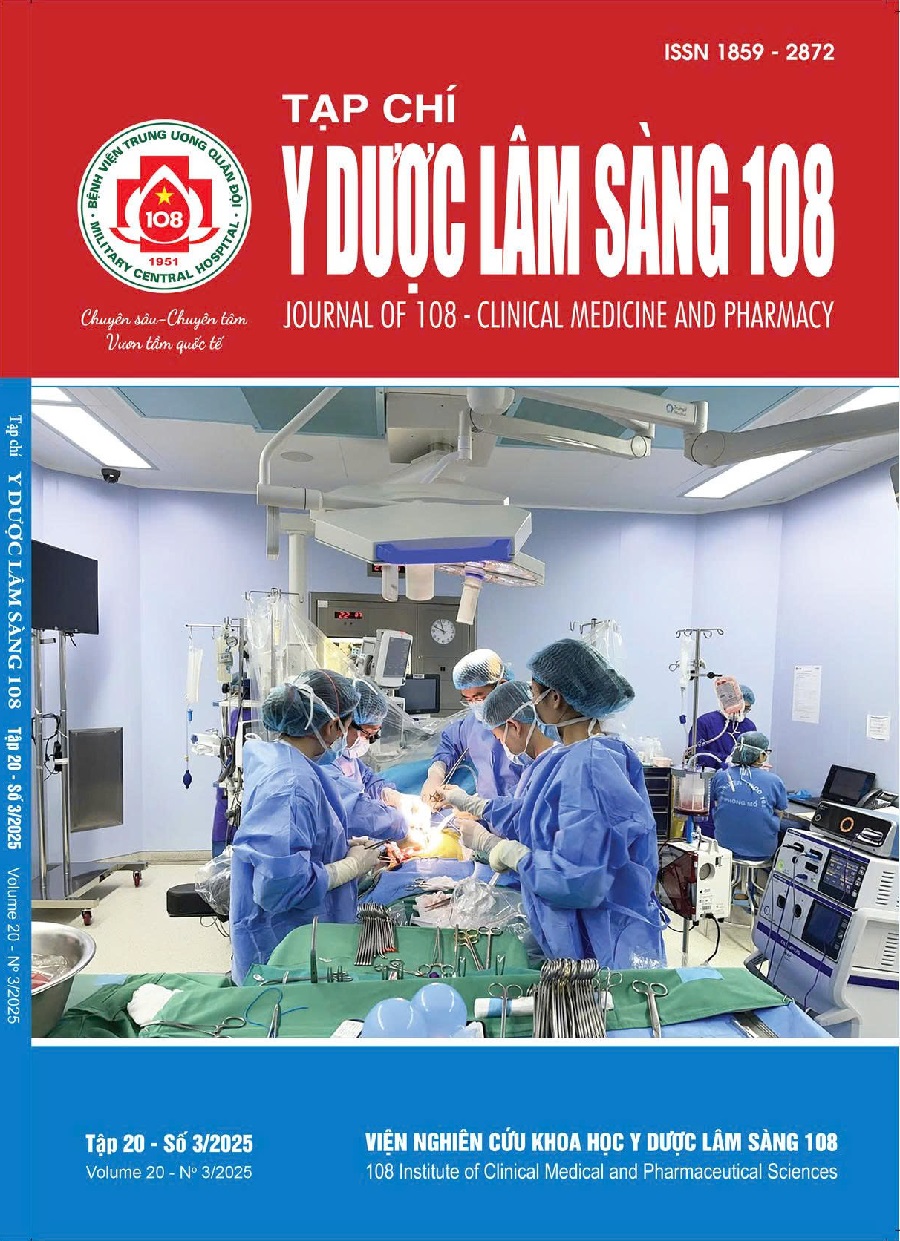Tình trạng phơi nhiễm virus viêm gan E ở sản phụ quý III thai kỳ nhiễm virus viêm gan B
Main Article Content
Keywords
Tóm tắt
Mục tiêu: Xác định tỷ lệ nhiễm virus viêm gan E (Hepatitis E virus - HEV) ở phụ nữ có thai bị viêm gan B mạn tính và đánh giá mối liên quan với một số đặc điểm lâm sàng và cận lâm sàng. Đối tượng và phương pháp: Nghiên cứu mô tả cắt ngang trên 100 sản phụ quý III thai kỳ nhập viện vì lý do chuyển dạ đẻ, kết hợp với nghiên cứu trong phòng thí nghiệm. Kết quả: Trong 100 sản phụ có 67 trường hợp (67%) có kết quả HBsAg dương tính, nồng độ HBsAg là 4019,8 (1480-6131,2) S/CO, 25 sản phụ (25%) dương tính với kháng thể IgG kháng HEV, 2 sản phụ (2%) dương tính với kháng thể IgM kháng HEV. Tỷ lệ sản phụ nhiễm HBV mang kháng thể IgG kháng HEV là 17/67 trường hợp (25,4%) và các sản phụ nhiễm HBV mang kháng thể kháng HEV có nồng độ HBsAg trung bình là 2955,7 (2176,4 - 5002,3) S/CO, mức độ enzyme gan ALT cao hơn và thời gian đông máu ngắn hơn so với nhóm còn lại. Kết luận: Tình trạng phơi nhiễm HEV làm thay đổi thời gian APTT và ALT ở phụ nữ có thai quý III thai kỳ nhiễm HBV và chưa phát hiện sự liên quan nồng độ HBsAg với tình trạng đồng nhiễm HEV-HBV.
Article Details
Các tài liệu tham khảo
2. Shalimar, Acharya SK (2013) Hepatitis E and acute liver failure in pregnancy. J Clin Exp Hepatol 3(3): 213-224.
3. Hoan NX, Tong HV, Hecht N et al (2015) Hepatitis E Virus Superinfection and Clinical Progression in Hepatitis B Patients. EBioMedicine 2(12): 2080-2086.
4. Lhomme S, Marion O, Abravanel F et al (2020) Clinical manifestations, pathogenesis and treatment of hepatitis E virus infections. J Clin Med, 9(2).
5. Mohamed R, Desmond P, Suh DJ et al (2004) Practical difficulties in the management of hepatitis B in the Asia–Pacific region. Journal of gastroenterology and hepatology 19(9): 958-969.
6. Hoan NX, Huy PX, Sy BT et al (2019) High Hepatitis E virus (HEV) Positivity Among Domestic Pigs and Risk of HEV Infection of Individuals Occupationally Exposed to Pigs and Pork Meat in Hanoi, Vietnam. Open Forum Infect Dis, 6(9): ofz306.
7. Chilaka VN, Konje JC (2021) Viral Hepatitis in pregnancy. Eur J Obstet Gynecol Reprod Biol 256: 287-296.
8. Mor G, Cardenas I (2010) The immune system in pregnancy: a unique complexity. Am J Reprod Immunol 63(6): 425-433.
9. Bigna JJ, Modiyinji AF, Nansseu JR et al (2020) Burden of hepatitis E virus infection in pregnancy and maternofoetal outcomes: A systematic review and meta-analysis. BMC pregnancy and childbirth, 20(1): 1-11.
10. Cao LC, Martin V, Linh LTK et al (2023) High Hepatitis E Virus (HEV) Seroprevalence and No Evidence of HEV Viraemia in Vietnamese Blood Donors. Viruses 15(10): 2075.
11. Velavan TP, Pallerla SR, Johne R et al (2021) Hepatitis E: An update on One Health and clinical medicine. Liver Int, 41(7): 1462-1473.
12. Qian Z, Li T, Xia Y et al (2023) Genotype 4 Hepatitis E virus replicates in the placenta, causes severe histopathological damage, and vertically transmits to fetuses. Journal of Infection 87(1): 34-45.
13. Ma XX, Ji Y, Jin L et al (2021) Prevalence and clinical features of hepatitis E virus infection in pregnant women: A large cohort study in Inner Mongolia, China. Clin Res Hepatol Gastroenterol 45(4): 101536.
14. Chen C, Wang ML, Li WX et al (2024) Hepatitis E virus infection increases the risk of obstetric complications and perinatal adverse outcomes in pregnant women with chronic hepatitis B virus infection. Eur Rev Med Pharmacol Sci 28(5): 1904-1912.
15. Dachlan EG, Nugraheni C, Rahniayu A, Aldika Akbar MI (2020) Quantitative HBsAg and qualitative HBeAg predicts intrauterine placental infection and umbilical blood cord in pregnant women. Journal of Family & Reproductive Health 14(2): 106-115.
 ISSN: 1859 - 2872
ISSN: 1859 - 2872
